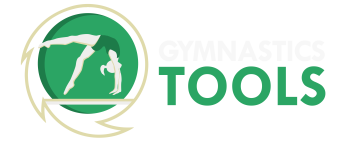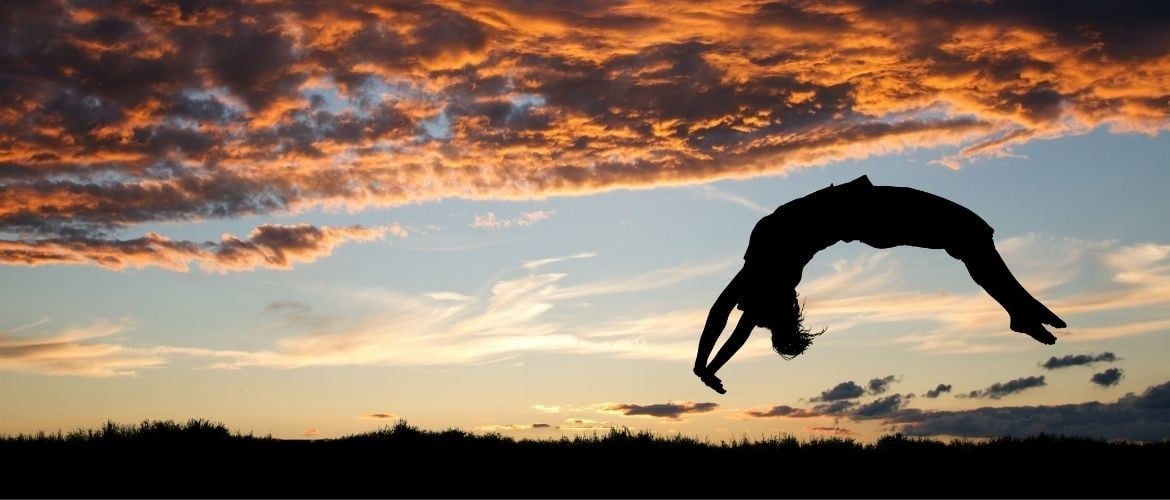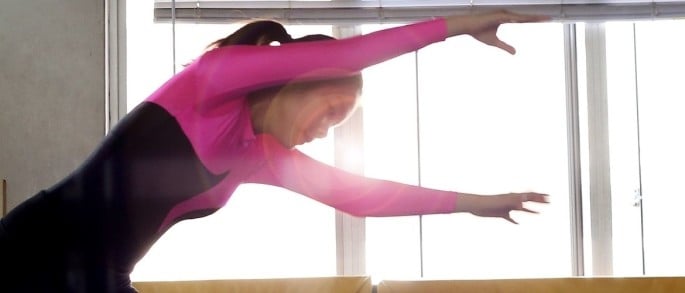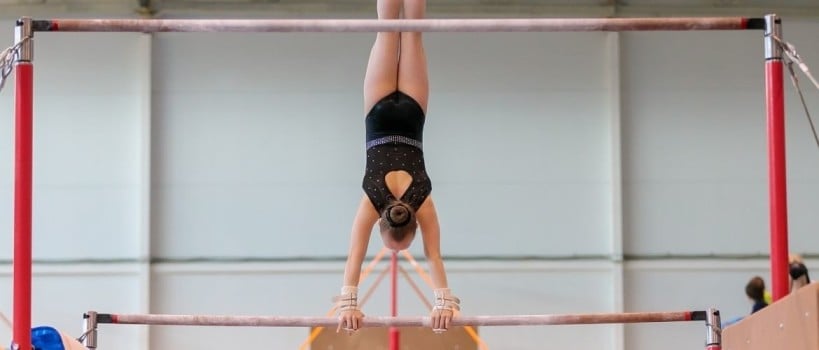The back handspring is a very famous gymnastics skill. It’s a common skill in the compulsory routines and often a requirement in the optional routines. In most country`s there’s a requirement for example that goes like this: “a flight skill backwards with hand placement”. There’s no denying it, that’s a back handspring. The skill is often used as a connection in acrobatic lines on floor or beam and remains important in higher levels as well.
In this article, I would like to go through the technique of the back handspring using the basic bio-motor abilities coordination, flexibility, strength and speed. I would also like to go through some methodical exercises to teach the different phases of the back handspring. I will first describe the movement.
1. Phases Back Handspring
Phase 1: start
The start position of the back handspring is a tall standing position with arms by the ears.
Phase 2: fall
In the next phase, the centre of gravity of the body is positioned backwards by letting yourself fall backwards. An implicit example to create this reaction can be to imagine you are going to sit down on a chair. The hips are slightly bent and the chest is in a hollow position. The arms are still by the ears.
Phase 3: arch
Stretch your legs by actively pushing them away from the floor. Open your hips, chest and shoulders while still keeping your arms by your ears.
Phase 4: landing
You land in an “arched handstand”, or the arching in the courbette action, while your hands touch the floor. The hips are slightly opened, your chest is raised and the shoulders are completely opened.
Phase 5: push off
Push off explosively through your shoulders while keeping your arms straight. A fast action from arch (phase 4) to hollow is created by a snap-down movement, also called the courbette action. The chest and ribs are pulled inwards and the hips are slightly bend backwards (so that the lower back is squared). The arms are still by the ears and the shoulders are still opened.
Phase 6: end position
The feet land on the floor, usually followed by a rebound.
Looking at the basic bio-motor abilities, requirements for the execution of the back handspring are:
- Coordination
- Snap-down / courbette action
- Hand placement in backwards movement; you cannot see the landing
- Flexibility
- Shoulders
- Hips
- Back
- Speed
- Snap-down / Courbette: fast arch-hollow action
- Push off fast through shoulders
- Quickly straighten legs
- Strength
- Shoulder strength
- Arm strength
- Tightening legs: straightening and closing
Make sure all these motor abilities are trained when learning the back handspring. Below, you will find two examples of mistakes in the technique. We will look at them and give you solutions to fix them.
Example 1

This is phase 3 of the back handspring, the arch phase. In the picture, you can see that the shoulders aren’t completely opened and that the arms and legs are bent. Looking at the bio-motor abilities, there’s the possibility that the shoulders aren’t completely opened because some flexibility is missing. The arms and legs might miss some tightening in the straight position.
Example 2
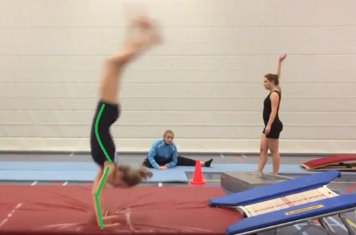
In this image, you see phase 4 of the back handspring. This would be the landing on the hands. This is also the arch movement of the courbette. In this example, you again notice shoulders that aren’t completely opened and bent arms and legs. The bent arms cause a mistake because the gymnast cannot quickly push off through her shoulders this way. The arms will push off by bending and straightening. This causes a lot of energy to get lost and the snap-down motion will be less intense (coordination mistake).
2. How can you correct the mistake?
Open shoulders
When flexibility of the shoulders is missing, the mobility of the shoulder is insufficient. Use a flexibility exercise to increase the mobility.
Increase shoulder mobility
Execution: Place elbow on an elevated surface. Keep forearms vertically (differs from the image). Use a stick to hold on to if necessary. Push the chest downwards. Prevent your lower back from arching. The stretch needs to be felt between the shoulder blades and underarms.
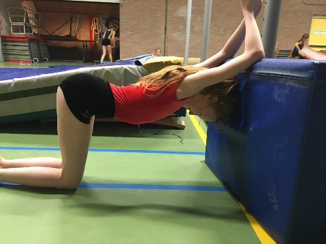
Parameters: hold for 4 x 20 seconds
Tightening of arms and shoulders
Execution: Place feet on elevated surface and hands on the floor. Completely open the shoulders and straighten the arms through and through. Make yourself as tall as possible to completely push through your shoulders.
The focus is on conciously keeping this tension.
You can add another focus to the exercise, namely “pushing through the shoulders”. Go down and push up through your shoulders while maintaining tension.

Parameters: Repeat 3 x 10 or until the quality of the execution diminishes.
Leg tightening
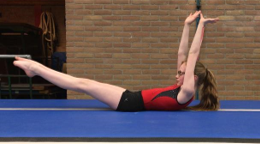
Use, for example, a basic tightening exercise for the legs in which the gymnast can consciously feel the leg straightening and closing. This can be done in a “bowl” or “banana” hold. You can also make the exercise more specific by executing the first phase of the back handspring to a landing on the back in a banana position. Straighten the legs completely in the first phase. Handstand exercises with a focus on straightening and closing the legs can also be very useful. When the gymnast can do the complete back handspring, you can chose to have the gymnast do the back handspring with an object between the ankles or knees. Closed legs are then the focus.
Drills & exercises to learn the back handspring
Are you interested in more methodical steps to learn the back handspring? Watch our exercises for the back handspring on our YouTube channel. Do you want access to all 2500 methodical steps? Join the Gymnastics Tools Platform.
